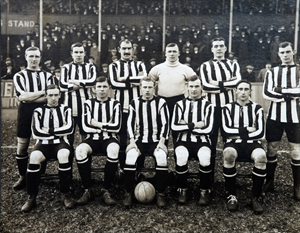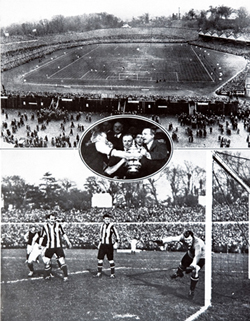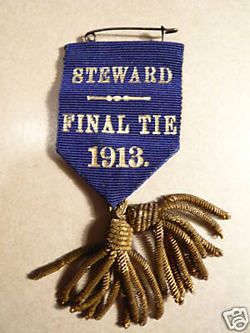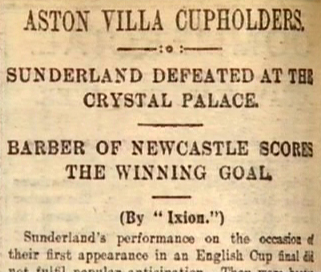
1913 fa cup final
aston villa 1 v 0 sunderland
The 1913 FA Cup final is a legendary game due to two main factors; it was played in front of a then world record crowd for a football match and it was the first time that the top 2 teams in England had competed for the most coveted domestic knockout trophy in then world football. To arrive at Crystal Palace, Sunderland had an arduous journey.
NUFC v SAFC 1913 Before the final itself at least one of the Sunderland players was physically sick from nerves. To carry the crowds from the North and Midlands, the L&NWR ran 41 specials, the GN 39, the GW 30, the Midland 23 and the GC 21. The main ones from the north east would be the Great Northern (GN) - i.e. what is now the East Coast Main Line to Kings Cross. For a guide on routes by London Terminal: L&NWR Euston, GW Paddington, Midland St Pancras and GC Marylebone (before the closures of the 1960s this served Leicester, Nottingham, Sheffield and across the pennies to Manchester. ___________________________________________
At Crystal Palace
One of the most interesting features of the final was the growth of the “rubber necking” industry. Parties of sightseers drove around the town under the tutelage of a stentorian guide to be told exactly what was what in tones that commanded attention. There must have been hundreds of such parties with the newest of motor buses evident alongside the oldest of brakes. There is surely no more gigantic or unrestrained merry making in the national calendar of festivities than this annual trek and especially when the streets were flooded with sunshine. To complete a glorious day the tournament at the Crystal Palace produced one of the best games, perhaps even the best game ever to be played in the shadow of that glazed monstrosity. It gathered together an enormous crowd. The peculiar shape of the Palace pitch makes it rather difficult to judge the pace of the game but there was never any doubt about the pace at which both teams set off. Neither side was playing their customary game and for the first few minutes Sunderland seemed all at sea. There were plainly traces of nerves in all three ranks of the team and Villa were clearly out to score early. Hampton and Thomson began their eagerly anticipated duel early on and with neither of them standing on ceremony the exchanges were the most conspicuous if not the most pleasing incidents in the 1st half. Thomson once deliberately made a back for Hampton who fell heavily and Mr. Adams found it necessary to caution the Sunderland man. It was a glaring infringement but in fairness it must be said that the Villa player was constantly jumping for the ball in a way that might easily have been penalised as dangerous play.
Villa had another disappointment almost immediately afterwards when Hampton put the ball into the net but the point was rightly disallowed for offside. When the Sunderland forwards did get going they reversed the Villa methods. Their halfbacks were too hard pressed to be able to pass accurately but occasionally Cuggy and Low managed to send the ball to their wing men. They were often quick to see Richardson well placed and the centre forward made ground rapidly but was always checked by a half back who was playing with more energy than skill. By the interval Villa had the better of a well contested 1st half but for a while after the restart Sunderland were just as much on top as Villa had been in the opening stages. All the best play was seen in a tense 20 minutes of absorbing football. It began with Martin sprinting in to catch Hardy with the ball and in the subsequent challenge the keepers left knee was so badly hurt he had to leave the field. Harrop took his place in goal and the Sunderland forwards were soon swarming round him. Twice he extricated himself from dangerous situations in a way that had only its success as its excuse and the run of play must have raised high hopes amongst Sunderland supporters. Hardy returned after about 10 minutes with a limp and a heavily bandaged leg. He was greeted with cheers that served to put fresh heart into Villa and they attacked immediately with Wallace forcing a corner off Ness. It was placed to perfection, at just the right height and with an awkward swerve to keep it clear of the defenders.
Although Sunderland were playing with every ounce of energy at their disposal they seemed incapable of making any impression. Martin had the goal at his mercy but his shot struck an upright and this failure sealed Sunderland's fate. It is impossible to deny that Villa deserved to win. Their margin of superiority was nevertheless very slight and a little bit of luck might have decided the match either way. The Villa forwards were better but behind them there was little to choose though Thomson’s fine defensive work tipped the balance in favour of Sunderland’s halfback line. Both sets of full backs played strongly if not brilliantly and Lyons who alone had twice prevented goals while Hardy was off injured was the best defender on the field. Altogether it was a game to live in football history. Aston Villa: Hardy, Lyons, Weston, Barber, Harrop, Leach, Wallace, Stephenson, Hampton, Halse, Bache Sunderland: Butler, Gladwin, Ness (pictured on the previous page), Cuggy, Thomson, Low, Mordue, Buchan, Richardson, Holley, Martin Referee: Mr. A Adams, Nottingham Attendance: 121,919 ________________________________ News of the defeat reached Roker Park where the Monkwearmouth Charity Cup Final between Southwick and Horden Athletic was being played. There was a deathly hush. On that day Wearmouth Colliery defeated Carol Street 6 v 1, a match which carried little significance but would become a destined place for Sunderland as the 20 Century drew to a close. |

 In the hours just after dawn Sunderland supporters were greatly in the majority in the capital and it was surprising to see how many had made the long and tiring journey. Still more surprising to see was how little it had dampened their spirits. They came pouring out of Kings Cross as though 6 or 7 hours of close confinement in a crowded railway carriage was no more than incidental and single mindedly fell upon the eating houses in the vicinity. They quickly made a marked impression on the huge provision made by caterers who obviously knew something of the capacity of the average excursionist.
In the hours just after dawn Sunderland supporters were greatly in the majority in the capital and it was surprising to see how many had made the long and tiring journey. Still more surprising to see was how little it had dampened their spirits. They came pouring out of Kings Cross as though 6 or 7 hours of close confinement in a crowded railway carriage was no more than incidental and single mindedly fell upon the eating houses in the vicinity. They quickly made a marked impression on the huge provision made by caterers who obviously knew something of the capacity of the average excursionist. The Villa forwards were quite distinctly better at the long passing game that both sides were employing. Hampton sent some beautiful passes out to the wings and gave Wallace opportunities that were put to such good use that the Roker defence was often severely taxed to master the rushes that followed his centres. In one of these onslaughts Gladwin brought Stephenson crashing to the ground in the penalty area and there were groans of disappointment when Wallace sent the kick yards wide of the left hand post.
The Villa forwards were quite distinctly better at the long passing game that both sides were employing. Hampton sent some beautiful passes out to the wings and gave Wallace opportunities that were put to such good use that the Roker defence was often severely taxed to master the rushes that followed his centres. In one of these onslaughts Gladwin brought Stephenson crashing to the ground in the penalty area and there were groans of disappointment when Wallace sent the kick yards wide of the left hand post. It sailed hard and true to where Barber was standing and there was a hurricane of applause when the halfback promptly headed it out of Butlers reach and into the net. The game was drawing rapidly to a close when the goal was scored and Villa took no chances by kicking out from every position that threatened trouble. The forwards helped them by striving as hard for another goal as though the match depended on it. Near the close Hampton made a great attempt to hustle Butler over the line.
It sailed hard and true to where Barber was standing and there was a hurricane of applause when the halfback promptly headed it out of Butlers reach and into the net. The game was drawing rapidly to a close when the goal was scored and Villa took no chances by kicking out from every position that threatened trouble. The forwards helped them by striving as hard for another goal as though the match depended on it. Near the close Hampton made a great attempt to hustle Butler over the line. Sunderland competed in their first English Cup Final and lost, in part due to nerves. This was the closest we would ever come to winning the double. Inexplicably the normally steady Charlie Thomson folded and in the second half had a running feud with Villa’s Hampton. Both were suspended the following season until the end of October. The referee Mr. Adams from Nottingham was also suspended, having allowed no less than 17 minutes for stoppage time. He would retire. Defeated or not this game is writ large in the history of Sunderland AFC.
Sunderland competed in their first English Cup Final and lost, in part due to nerves. This was the closest we would ever come to winning the double. Inexplicably the normally steady Charlie Thomson folded and in the second half had a running feud with Villa’s Hampton. Both were suspended the following season until the end of October. The referee Mr. Adams from Nottingham was also suspended, having allowed no less than 17 minutes for stoppage time. He would retire. Defeated or not this game is writ large in the history of Sunderland AFC.